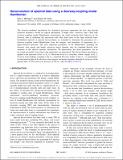| dc.contributor.author | Bittinger, Kyle Lee | |
| dc.contributor.author | Field, Robert W. | |
| dc.date.accessioned | 2011-09-21T19:12:07Z | |
| dc.date.available | 2011-09-21T19:12:07Z | |
| dc.date.issued | 2010-04 | |
| dc.date.submitted | 2009-11 | |
| dc.identifier.issn | 0021-9606 | |
| dc.identifier.uri | http://hdl.handle.net/1721.1/65913 | |
| dc.description.abstract | The doorway-mediated mechanism for dynamical processes represents the first step beyond statistical dynamics toward an explicit mechanism. A bright state→doorway state→dark bath doorway-coupling model Hamiltonian characterizes the small molecule limit behavior of the doorway state in mediating the interaction with other dark states in the large molecule limit. Established methods of spectral deconvolution are extended to determine the parameters of a doorway-coupling model Hamiltonian from the energies and intensities of eigenstates in a high-resolution spectrum. The most important parameters of the Hamiltonian, including the doorway state energy and bright ∼ doorway matrix element, may be computed directly from moments of the spectral intensity distribution. We demonstrate that these parameters can be recovered accurately even when some eigenstates are unresolved. The deconvolution procedure is applied to the spectrum of the 3ν3 Ka = 1 [3V subscript 3 K subscript a = 1] vibrational level of S1 [S subscript 1] acetylene, where a single, local, T3 [T subscript 3] doorway level mediates coupling to the T1,2 [T subscript 1,2] manifold. Previous studies of this S1 ∼ T3 [S subscript 1 ∼ T subscript 3] perturbation are discussed in light of the doorway state energies and matrix elements obtained by inversion of the spectral data. | en_US |
| dc.language.iso | en_US | |
| dc.publisher | American Institute of Physics | en_US |
| dc.relation.isversionof | http://dx.doi.org/10.1063/1.3357311 | en_US |
| dc.rights | Article is made available in accordance with the publisher's policy and may be subject to US copyright law. Please refer to the publisher's site for terms of use. | en_US |
| dc.source | Prof. Field via Erja Kajosalo | en_US |
| dc.title | Deconvolution of spectral data using a doorway-coupling model Hamiltonian | en_US |
| dc.type | Article | en_US |
| dc.identifier.citation | Bittinger, Kyle L., and Robert W. Field. “Deconvolution of Spectral Data Using a Doorway-coupling Model Hamiltonian.” The Journal of Chemical Physics 132.13 (2010) : 134302. © 2010 American Institute of Physics | en_US |
| dc.contributor.department | Massachusetts Institute of Technology. Department of Chemistry | en_US |
| dc.contributor.approver | Field, Robert W. | |
| dc.contributor.mitauthor | Bittinger, Kyle Lee | |
| dc.contributor.mitauthor | Field, Robert W. | |
| dc.relation.journal | Journal of Chemical Physics | en_US |
| dc.eprint.version | Final published version | en_US |
| dc.type.uri | http://purl.org/eprint/type/JournalArticle | en_US |
| eprint.status | http://purl.org/eprint/status/PeerReviewed | en_US |
| dspace.orderedauthors | Bittinger, Kyle L.; Field, Robert W. | en |
| dc.identifier.orcid | https://orcid.org/0000-0002-7609-4205 | |
| mit.license | PUBLISHER_POLICY | en_US |
| mit.metadata.status | Complete | |
